|
||
|
|
||
This page last updated April 21, 2024 |
Perhaps nothing can cause such a universal emotional response in drivers as the dreaded lane-ending-merge like the ones when a lane is closed for road work or a crash. We all know the drill — most people move out of the truncated lane early while a few seemingly self-important people take advantage of the empty lane to cut in at the front of the line, causing incalculable road rage amongst those waiting patiently in the through lane. Even some of those people cutting in at the front feel the stress of that tense, last-second merge while knowing that they're now the target of disdain of dozens of people behind them. It's even worse for the innocent, well-meaning motorist who tried to get in earlier but was blocked by self-defeating road vigilantes.
In Texas and most states, legally, there is no requirement to merge until the taper point. Therefore, this situation exposes a deep-seated philosophical argument: Is it better to merge early, which has been the traditional way of doing it, or wait and merge "late", i.e. at the point where the lane ends?

merge sign
Most drivers are either taught, or learn on their own (often instinctively), to merge early. That just seems to be the "right" thing to do on so many levels. And sometimes, it is indeed the right thing to do.
But traffic experts have discovered in recent years that sometimes it's actually the wrong thing to do, and the late merge has now become the recommended procedure in a number of states including Minnesota, Wisconsin, Washington, Missouri, and Kansas, as well as in much of Europe, where in Germany it's actually the law. It's also supported and recommended by the American Automobile Association (AAA).
|
ADVERTISEMENT |
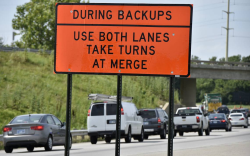
 The "late merge", known more descriptively as the "Zipper Merge", is when drivers fill up both lanes and then take turns merging one-at-a-time at the point where one lane ends. That one-at-a-time merge is where the "zipper" name comes from.
The "late merge", known more descriptively as the "Zipper Merge", is when drivers fill up both lanes and then take turns merging one-at-a-time at the point where one lane ends. That one-at-a-time merge is where the "zipper" name comes from.
Research has shown that this method is safer and helps to keep things moving more smoothly through the merge point because drivers are cooperating and creating gaps, thus eliminating brute force injections into the through lane. It's those sudden, unexpected forced merges, especially from a standing stop, that causes shock waves in the traffic flow that creates the stop-and-go conditions often seen in these situations.
Here is why it works:
- When people take turns and know that's the expectation, they can gradually open a gap earlier while still moving.
- Drivers in the closed lane can better predict where they'll merge, align themselves, and merge smoothly and safely without having to stop.
- Because everyone keeps moving, it eliminates shockwaves in the traffic stream, which reduces the risk of rear-end collisions, and drivers feel less stressed because traffic is still moving.
- By using the full capacity of the truncated lane, the length of the backup is reduced correspondingly. This means less likelihood of congestion extending beyond the work zone warning signs — when that happens, there is an increased likelihood of rear-end collisions and forced merges.
These circumstances together result in a smoother, safer, and more consistent traffic flow, and studies have shown it can reduce congestion by up to 40%.
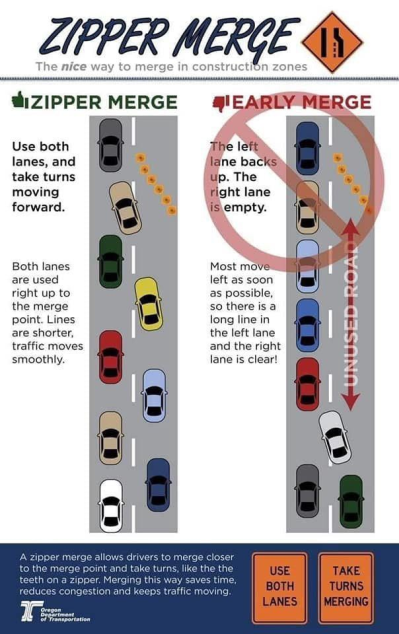
| The Zipper Merge fills the lane that is closed, thereby preventing opportunistic drivers from taking advantage of an empty lane to zip past everyone (pun unintended) waiting in the through lane. |
Furthermore, if both lanes are used, they will tend to even themselves out, which then makes it fair for everyone, i.e. the person you let in at the merge point will have been waiting about as long as you have.
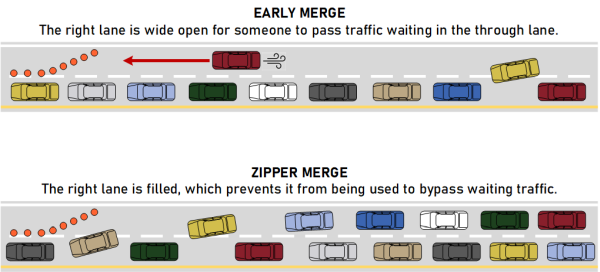
Furthermore, it's hard to break such a deeply-ingrained habit and belief system. I myself know the benefits of the Zipper Merge, but I still often feel that visceral need to merge early because that's what I've been taught for so long.
Therefore, a significant public education campaign, along with signage in work zone merge areas, is needed to make the program work. Studies have shown that when this is done, the benefits are realized.
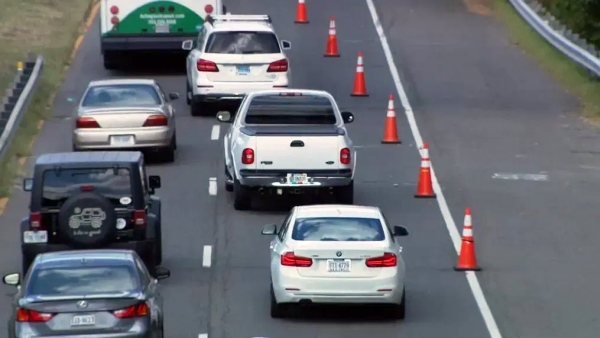
But in those instances when traffic is free-flowing through a lane drop (like in the photo below), then the early merge is the best thing to do. Merging early in this situation is safer and helps to maintain the free-flow of traffic because, as mentioned before, drivers who wait until the very last minute often need to slow considerably or even come to a stop in order to merge, or will sometimes just shove themselves into the through lane. Someone in the through lane then has to slow considerably or even stop to allow them to merge, which then causes the person behind them to slow or stop, and the dominoes fall from there and becomes the genesis of a traffic jam or, worse, a rear-end collision. Merging well in advance in that situation allows drivers to find and enter a gap when other drivers only need to make minor adjustments to their spacing while maintaining speed, thus preserving the traffic flow.
- When traffic is already slowing or congested, use the Zipper Merge. Merging early is pointless and even counterproductive in this situation.
- When traffic is free-flowing, merge early. Doing so in this situation is safer and can prevent congestion from forming.
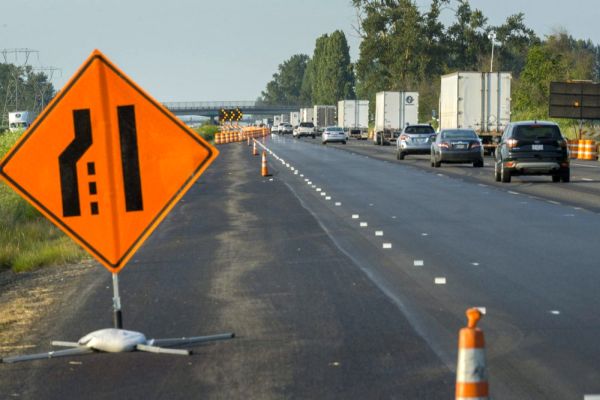
Other sites of interest
There is a plethora of articles and websites about the Zipper Merge, but here are a few good ones.


